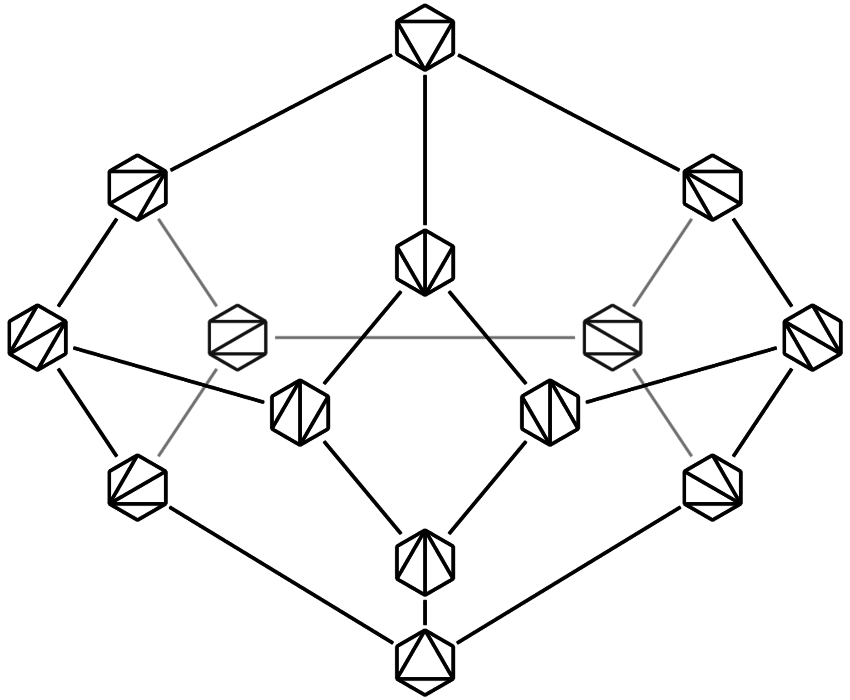Associahedra in Quantum Field Theory
Posted by John Baez
I haven’t been carefully following quantum field theory these days, but some folks on the Category Theory Community Server asked me what I thought about recent work using the ‘amplitudohedron’ and other polytopes, so I decided to check out these videos:
- Nima Arkani-Hamed, Advanced class on amplitudes.
There are 5, and so far I’ve only finished watching the first. But I have to say: I enjoyed it more than any lecture on physics I’ve seen for a long time!
Arkani-Hamed has the amusing, informal yet clear manner of someone like Feynman or Coleman. And he explains, step by step, how imaginary particle physicists in some other universe could have invented the associahedra just by doing scattering experiments and looking for poles in the S-matrix. That blew my mind.

One great thing is that Arkani-Hamed keeps the prerequisites to a minimum. Well, okay: if don’t know quantum field theory don’t watch this video. You need to know the Feynman rules, and how Feynman diagrams have poles when the energy-momentum of a virtual particle in the diagram goes ‘on shell’ — i.e., takes a value that a real particle could have, namely for a particle of mass . It also helps to have seen how Feynman diagrams for gauge bosons can be drawn as ‘ribbon graphs’. But he’s remarkably good at keeping things simple.
Beginners may, however, not fully understand his assumptions. He says he’s talking about the theory. This is the theory of a spin-0 field of mass that takes values in the Lie algebra , with a cubic interaction Lagrangian
At this point some raw beginners should be told: this describes a universe unlike our own! When he sets , this theory would apply to nonexistent ‘spin-zero gluons’.
More importantly, he doesn’t say why he’s only considering planar, tree-shaped Feynman diagrams! This restriction kicks in naturally only when we consider the limit , so I assume that’s what he’s implicitly doing. There’s a long line of work on the large- limit of Yang–Mills theory, and how in this limit we can do a expansion where the terms of order correspond to Feynman diagrams that can first be drawn on a surface of genus .
Once Arkani-Hamed restricts himself to planar, tree-shaped Feynman diagrams, he is studying trees drawn on a disk, with 3 edges meeting at each vertex because of the 3 in the theory. At this point the appearance associahedra becomes inevitable — because trees of this kind are precisely the vertices of associahedra! Arkani-Hamed draws these trees dually as ways of connecting up the vertices of a polygon to chop it into triangles:
Restricting to tree-shaped Feynman diagrams is an extreme simplification, so it’s not clear how close to the essence of quantum field theory we are getting. Luckily I just listened to his second lecture, and he said that in the third lecture he’d consider diagrams with loops.
Unfortunately, by the time the pop science media get ahold of Arkani-Hamed’s work, they drop all inhibitions and say stuff like “physicists have discovered a jewel-shaped geometric object that challenges the notion that space and time are fundamental constituents of nature”. Why does everything need to assume cosmic significance? Why can’t some work just be interesting?
But enough complaining! Arkani-Hamed’s talk has excited me to the point where I’m having a new fantasy about the future of fundamental physics. Attempts to cook up a theory of quantum gravity remain stalled. People turn to studying what already works: quantum field theory. They start finding more and more new structures there. Eventually this changes our picture of what quantum field theory is to the point where it breaks the logjam we’re experiencing today. Not only do people figure out how to make nonperturbative quantum field theory fully rigorous, they figure out things we can’t imagine yet… and eventually this leads to really earth-shaking developments.
Indeed, many exciting things are already going on. We’ve got Costello, Gwilliam and others bringing modern math to bear on quantum field theory using factorization algebras, we’ve got Connes, Marcolli and others studying the connection between quantum field theory and motives, we’ve got work on how perturbative quantum gravity is like a ‘double’ of Yang–Mills theory, we’ve got attempts to find Yang–Mills theory hiding inside the theory, we’ve got Wang and others applying TQFT ideas to the Standard Model and GUTs, and a lot more.
So, I want to keep a bit of an eye on this stuff. What are the most exciting developments you’ve seen lately in quantum field theory on Minkowski spacetime?


Re: Associahedra in Quantum Field Theory
I’m happy to hear you’re re-interested in QFT! I get a little depressed every time you go off to work on climate change (even though that’s important) or pure math (even though that’s fascinating) but console myself that you’ll inevitably return, because your knowledge and skill in mathematical physics and its exposition are unparalleled and the subject is compelling.
I do have two directions in QFT of potential interest. One is the paper that’s (after a two month hold, perhaps a new record) on hep-th:
C, P, T, and Triality
and the second I don’t wish to talk about publicly but can privately if you’d like.